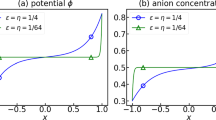Abstract
This chapter discusses 2 X 2 symmetric variational formulations and associated finite element methods for the EMI equations. We demonstrate that the presented methods converge at expected rates, and compare the approaches in terms of approximation of the transmembrane potential. Overall, the choice of which formulation to employ for solving EMI models becomes largely a matter of desired accuracy and available computational resources.
Chapter PDF
Similar content being viewed by others
References
Babuška I (1973) The finite element method with Lagrangian multipliers. Numerische Mathematik 20(3):179–192
Babuška I, Gatica GN (2003) On the mixed finite element method with Lagrange multipliers. Numerical Methods for Partial Differential Equations: An International Journal 19(2):192–210
Boffi D, Brezzi F, Fortin M, et al. (2013) Mixed Finite Element Methods and Applications, vol 44. Springer Berlin Heidelberg, Berlin, Heidelberg
Chandler-Wilde SN, Hewett DP, Moiola A (2015) Interpolation of Hilbert and Sobolev spaces: quantitative estimates and counterexamples. Mathematika 61(2):414–443
Evans LC (2010) Partial Differential Equations, vol 19. American Mathematical Soc., Providence, Rhode Island
Girault V, Raviart PA (2012) Finite Element Methods for Navier-Stokes Equations: Theory and Algorithms, vol 5. Springer Berlin Heidelberg, Berlin, Heidelberg
Jæger KH, Tveito A (2020) Derivation of a cell-based mathematical model of excitable cells. In: Tveito A, Mardal KA, Rognes ME (eds) Modeling Excitable Tissue - The EMI Framework, Simula Springer Notes in Computing, SpringerNature
Jæger KH, Hustad KG, Cai X, Tveito A (2020) Operator splitting and finite difference schemes for solving the EMI model. In: Tveito A, Mardal KA, Rognes ME (eds) Modeling Excitable Tissue - The EMI Framework, Simula Springer Notes in Computing, SpringerNature
Könnö J, Schötzau D, Stenberg R (2011) Mixed finite element methods for problems with Robin boundary conditions. SIAM Journal on Numerical Analysis 49(1):285–308
Kuchta M, Mardal KA (2020) Iterative solvers for cell-based EMI models. In: Tveito A, Mardal KA, Rognes ME (eds) Modeling Excitable Tissue - The EMI Framework, Simula Springer Notes in Computing, SpringerNature
Kuchta M, Nordaas M, Verschaeve JCG, Mortensen M, Mardal KA (2016) Preconditioners for saddle point systems with trace constraints coupling 2D and 1D domains. SIAM Journal on Scientific Computing 38(6):B962–B987
Kuchta M, Mardal KA, Rognes ME (2020) Software for EMI - Solving the EMI equations using finite element methods. https://doi.org/10.5281/zenodo.3769254, URL https://doi.org/10.5281/zenodo.3769254
Wohlmuth BI (2000) A mortar finite element method using dual spaces for the Lagrange multiplier. SIAM Journal on Numerical Analysis 38(3):989–1012
Author information
Authors and Affiliations
Corresponding author
Editor information
Editors and Affiliations
Rights and permissions
Open Access This chapter is licensed under the terms of the Creative Commons Attribution 4.0 International License (http://creativecommons.org/licenses/by/4.0/), which permits use, sharing, adaptation, distribution and reproduction in any medium or format, as long as you give appropriate credit to the original author(s) and the source, provide a link to the Creative Commons license and indicate if changes were made.
The images or other third party material in this chapter are included in the chapter's Creative Commons license, unless indicated otherwise in a credit line to the material. If material is not included in the chapter's Creative Commons license and your intended use is not permitted by statutory regulation or exceeds the permitted use, you will need to obtain permission directly from the copyright holder.
Copyright information
© 2021 The Author(s)
About this chapter
Cite this chapter
Kuchta, M., Mardal, KA., Rognes, M.E. (2021). Solving the EMI Equations using Finite Element Methods. In: Tveito, A., Mardal, KA., Rognes, M.E. (eds) Modeling Excitable Tissue. Simula SpringerBriefs on Computing(), vol 7. Springer, Cham. https://doi.org/10.1007/978-3-030-61157-6_5
Download citation
DOI: https://doi.org/10.1007/978-3-030-61157-6_5
Published:
Publisher Name: Springer, Cham
Print ISBN: 978-3-030-61156-9
Online ISBN: 978-3-030-61157-6
eBook Packages: Mathematics and StatisticsMathematics and Statistics (R0)




